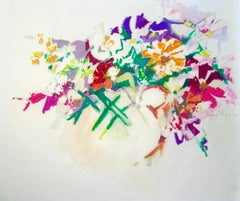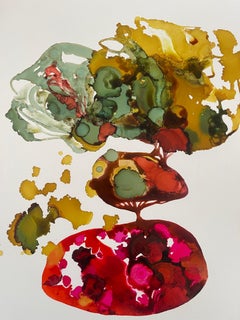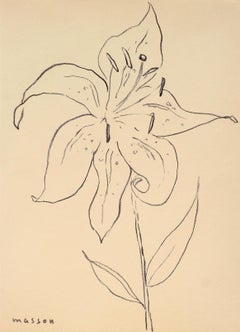André Masson Still-life Drawings and Watercolors
Born in 1896 in Balagny-sur- Thérain, a small village in France, André Masson spent most of his youth in Brussels, Belgium working as a pattern maker at an embroidery atelier. Masson began his schooling in 1907 at the Académie Royale des Beaux-Arts in Brussels. In 1912, he relocated to Paris, where he attended the École des Beaux-Arts. In 1914, the artist was called to military duty for the First World War, where he was severely wounded and sent back to Paris. Much of Masson’s work is influenced by this trauma; his drawings and paintings executed during the 1920s represent battle scenes, blood, death, birds and fish. The strange realities of trench warfare and the immediate contiguity of life and death are drawn upon, and his imagery suggests a confrontation of life at an abnormal level of experience. His signature style deals with violence, evident in terrifying, fragmented figures, which reflect the horrors of the Spanish Civil War and WWII, as well as his troubled psyche in the aftermath of his service in WWI.
After WWI, Masson moved to the South of France, where he met Juan Gris, André Derain, Joan Miró and André Breton. Breton championed the Surrealist Manifesto and Masson joined in the group exhibition of the first Surrealists. An iconoclast, whose abrupt stylistic transitions defy classification, Masson also explored automatism (automatic drawing), a process that sought to express the creative force of the unconscious. These automatic drawings had no preconceived subject or composition. Like a medium channeling a spirit, Masson let his pen travel rapidly across the paper without conscious control. He soon found hints of images, fragmented bodies and objects, emerging from the abstract, lacelike web of pen marks. At times, Masson elaborated on these with conscious changes or additions, but he left the traces of the rapidly drawn ink mostly intact. Masson’s oeuvre explores several techniques of painting, drawing and sculpture and displays rich, colorful abstraction as well as monochrome imagery and automatic linear representations. An early Surrealist and student of Cubism, Masson went on to inspire the New York Abstract Expressionists. Masson developed a technique of automatic painting that retained the element of chance; he dripped glue onto paper to form drawings and then covered it with sand. These ‘sand paintings’ are unquestionably his most iconic style.
When Masson emigrated to the U.S. in 1939, he strongly influenced several American painters with this technique, the most evident example being Jackson Pollack. After his time in America, he returned to Europe and while living in Spain during the mid-1930s, he became enraptured with Spanish themes—bullfights, matadors and Spanish mythology. Masson finally settled down in France (Aix-en-Provence), where he took up a late interest in impressionistic landscape, but he ultimately came to a place where he painted nearly exclusively abstract images. Masson dedicated his life as an artist to encouraging the non-rational purpose in art, to the direct transference of subconscious thought and to the primal forces of conflicts that he experienced in the trenches of World War One. Masson sought to convey in his work a deeper reality of man’s behavior, his own complex personal imagery, and his belief that painting is not a matter of developing style but a part of life itself.
Mid-20th Century Modern André Masson Still-life Drawings and Watercolors
Pencil, Carbon Pencil
1980s Abstract André Masson Still-life Drawings and Watercolors
Parchment Paper, Crayon, Pastel, Pencil
21st Century and Contemporary Contemporary André Masson Still-life Drawings and Watercolors
Paper, Ink, Watercolor
1980s Abstract André Masson Still-life Drawings and Watercolors
Parchment Paper, Crayon, Pastel, Pencil
2010s Pop Art André Masson Still-life Drawings and Watercolors
Charcoal, Pencil, Graphite
2010s Abstract André Masson Still-life Drawings and Watercolors
Paper, Graphite
Early 20th Century Ashcan School André Masson Still-life Drawings and Watercolors
Paper, Graphite
20th Century American Modern André Masson Still-life Drawings and Watercolors
Color Pencil
1930s Abstract Geometric André Masson Still-life Drawings and Watercolors
Paper, Watercolor, Gouache
1990s Abstract André Masson Still-life Drawings and Watercolors
Color Pencil
1990s Abstract André Masson Still-life Drawings and Watercolors
Paper, Charcoal, Pencil
Early 2000s Abstract Impressionist André Masson Still-life Drawings and Watercolors
Paper, Watercolor
Early 2000s Contemporary André Masson Still-life Drawings and Watercolors
Watercolor, Handmade Paper, Monoprint, Mixed Media, Graphite
1930s Modern André Masson Still-life Drawings and Watercolors
Paper, Graphite


